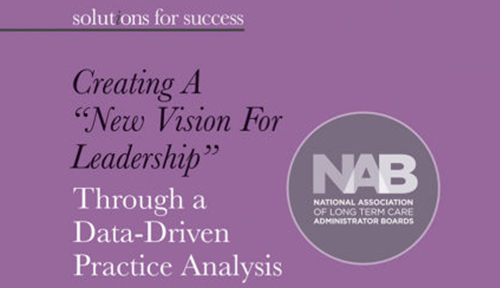Challenges and Opportunities: Since 1970 in compliance with a federal mandate, the National Association of Long-Term Care Administrator Boards (NAB) member state boards and agencies were given the responsibility of licensing nursing home administrators (NHA) in every US jurisdiction. Each state developed somewhat unique practice standards which created barriers to licensure portability. The one commonality was the licensure exam developed by NAB which is used in all jurisdictions. In the 1990s long term care services began to expand dramatically into residential care/assisted living (RCAL) communities, licensure followed in many states, and NAB responded with a national examination for RCAL administrators. In the following decade, a variety of home and community-based services ((HCBS) adult day care, home care, home health, hospice and palliative care) expanded the scope of services and states began to assess the need for licensing the managers of these additional lines of service. Licensure at the state level followed this expansion in many states. This industry expansion while offering a wide range of services to residents/customers further complicated licensure requirements, created unreasonable barriers to licensure and career paths, and portability to practice across state borders and lines of service. At the same time, the image of the profession was poor making it difficult to attract candidates into the profession. The Approach In 2014 Bostrom client the National Association of Long Term Care Administrator Boards (NAB) under the leadership of Bostrom President/NAB President and CEO Randy Lindner in partnership with NAB’s leadership, initiated a visioning and strategic planning process to explore a new vision for leadership that would end the practice of preparing leaders to work in a silo (i.e. a single line of service), develop a model to prepare them to work along multiple lines of service with a single qualification and remove regulatory barriers to practice. The NAB conducted a contemporary and aspirational professional practice analysis study across multiple lines of service (NHA, RCAL, and HCBS) to provide a basis for a forward-looking competency-based credential, the Health Services Executive (HSE).
- To investigate similarities and differences and identify
- Common or core domains, tasks and KSs*
- Specific or unique domains, task and KSs*
*KSs = Knowledge and Skills
- Establish an aspirational voluntary board-based qualification standard for the Health Services Executive (HSE) through “Licensure by Equivalency”
- Facilitate express licensure approval and transfer based on a common state standard
- Meet state licensure requirements for practice as an NHA, RCAL and HCBS administrator
- Promote consistency of the AIT and preceptor training experience across all jurisdictions
- Broaden academic programs to prepare graduates to meet the HSE qualification standards upon graduation
The study found that 82% of competencies are common across multiple lines of service. What followed was a complete transformation of and development of a new suite of programs to accredit academic degree programs, assess continuing education and training programs and a modular examination program to meet licensure requirements. The NAB also established an HSE Qualification to pre-qualify leaders in the field to meet licensure requirements across state lines and lines of service with a single qualification.





